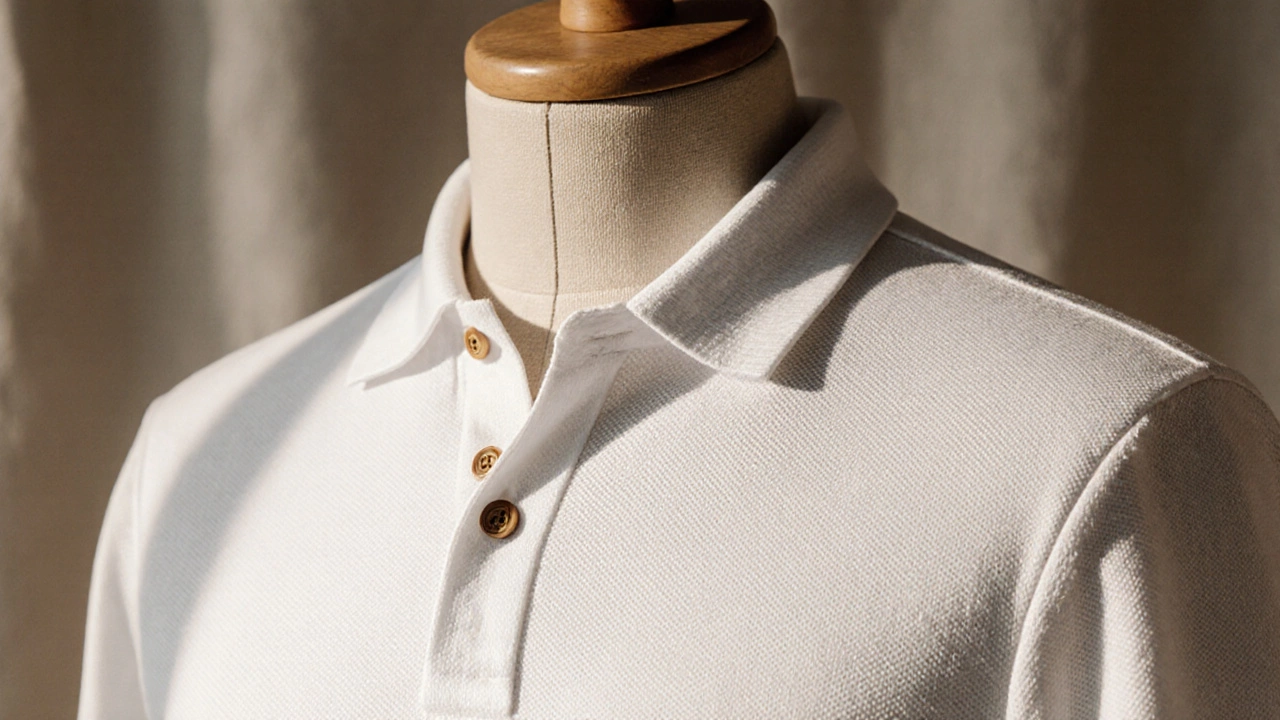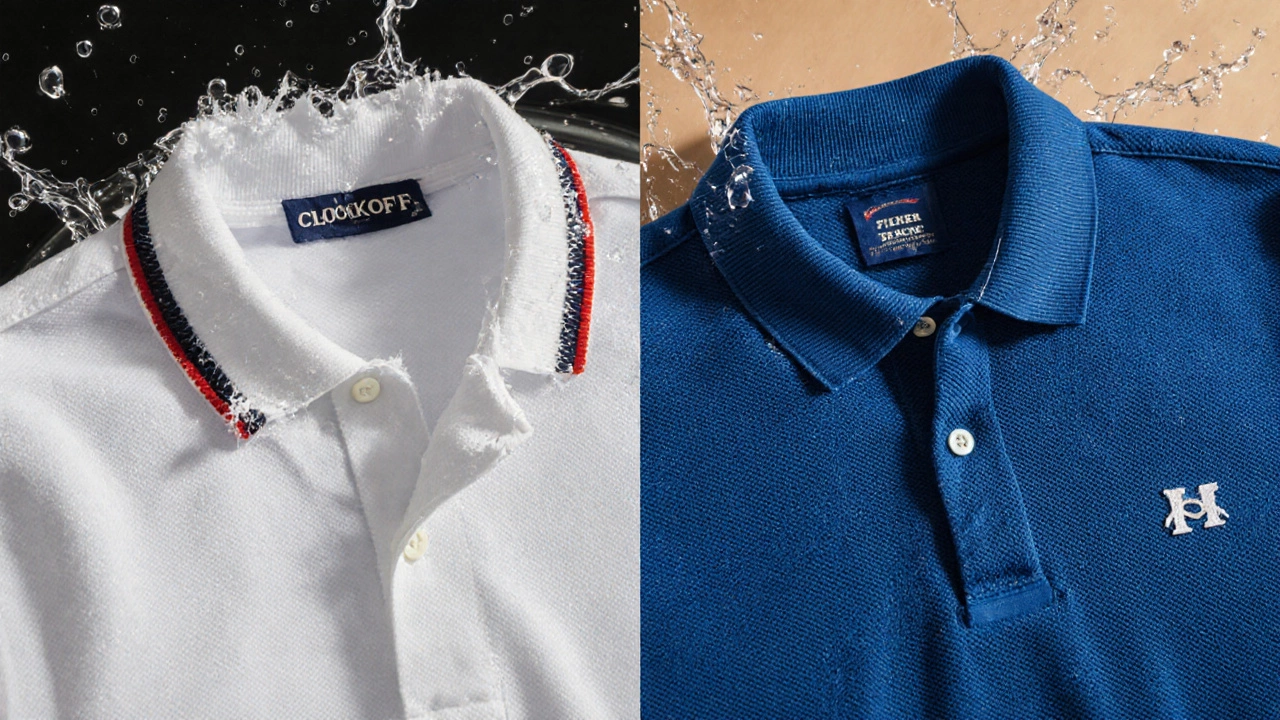What Do You Call a T-Shirt With a Collar? The Real Name and Why It Matters

Ever seen someone wearing a T-shirt with a collar and wondered what it’s actually called? You’re not alone. It’s one of those clothing items everyone recognizes but few can name correctly. You might call it a "collared T-shirt," "polo shirt," or even "button-down," but only one of those is right-and the difference matters more than you think.
It’s Not a T-Shirt at All
The thing you’re thinking of isn’t a T-shirt. Not really. A true T-shirt has no collar, no buttons, and no placket. It’s cut from a single piece of fabric with a simple round or crew neck. If it has a collar, it’s a different garment entirely. The correct name? Polo shirt.
The polo shirt got its name from the sport of polo, where players in the late 19th century needed something more practical than a stiff dress shirt. They started wearing short-sleeved, collared shirts with a few buttons at the top to keep the collar from flapping while riding. Lacoste, the French tennis player, popularized the design in the 1920s with his iconic crocodile logo. That’s how the modern polo shirt was born.
So if you’re wearing a shirt with a collar, a few buttons, and a knit fabric, you’re wearing a polo shirt-not a T-shirt with a collar. Calling it a "collared T-shirt" is like calling a sedan a "car with four doors." It’s technically true, but it misses the point.
How to Tell a Polo Shirt From a T-Shirt
Not all collared shirts are polos. Here’s how to spot the real thing:
- Collar type: Polo shirts have a soft, knit collar that lays flat or folds slightly. It’s not stiff like a dress shirt collar.
- Buttons: Most polos have 2 to 4 buttons at the placket, just below the collar. This lets you unbutton for ventilation or style.
- Fabric: Made from pique knit cotton or a cotton-poly blend. It’s textured, not smooth like a basic T-shirt.
- Sleeves: Short sleeves are standard. Long-sleeve versions exist but are rare and usually labeled as "long-sleeve polos."
- Fit: Slightly tailored, not baggy. It’s meant to look neat, not sloppy.
If your shirt has none of these features-just a collar glued on to a plain cotton tee-it’s probably a cheap knockoff. And those don’t count. Real polos are built to last, not just look like one.
What About Button-Down Shirts?
People often confuse polos with button-down shirts. They’re both collared and buttoned, but they’re worlds apart.
A button-down shirt is a dress shirt with a collar that has small buttons to fasten it to the shirt. It’s made from woven fabric, usually cotton, and designed to be worn with a tie. You wear it to job interviews, weddings, or board meetings. A polo shirt? You wear it to the grocery store, a backyard barbecue, or a casual Friday at work.
The fabric alone tells the story: woven vs. knit. One is crisp. The other is soft and stretchy. One needs ironing. The other doesn’t.

Why the Name Matters
Getting the name right isn’t about being pedantic. It’s about communication. If you’re shopping online and search for "T-shirt with collar," you’ll get a mess of results-some are polos, some are novelty shirts with fake collars, and some are just T-shirts with a stitched-on collar that falls apart after one wash.
But if you search for "polo shirt," you’ll find quality options from brands like Ralph Lauren, Lacoste, Perry Ellis, and even Uniqlo. You’ll see real product descriptions, sizing charts, and customer reviews that actually help you decide.
It’s the same with care labels. Polo shirts can usually be machine washed and dried. A T-shirt with a glued-on collar? That thing’s going to peel after a few washes. You’re not saving money-you’re wasting it.
When People Get It Wrong
Here’s the weird part: even big retailers mess this up. You’ll find Amazon listings that say "Men’s Collared T-Shirt" for what’s clearly a polo. Same with Walmart and Target. They do it because "T-shirt" gets more searches. But that’s misleading.
And then there’s the fashion crowd. Some influencers call anything with a collar a "collared tee" to sound trendy. But if you’re trying to build a real wardrobe, you need real terms. Knowing the difference helps you buy smarter.
Think of it like calling a sedan a "car with windows." It’s true, but you’re not going to get the right model at the dealership.

What to Look for When Buying
If you want a good polo shirt, here’s what to check:
- Material: 100% cotton pique is best. It breathes, holds its shape, and feels nice. Avoid 100% polyester-it traps heat and looks shiny.
- Weight: Look for 180-220 GSM (grams per square meter). Anything lighter feels flimsy. Anything heavier feels like a sweater.
- Stitching: Check the collar seam. It should be double-stitched. The placket buttons should be sewn on with a bar tack for durability.
- Fit: Should hug your torso without being tight. Sleeves should end at the midpoint of your bicep.
- Brand: Stick to known names for quality: Lacoste, Ralph Lauren, Brooks Brothers, J.Crew, Uniqlo, or even Amazon Essentials if you want budget-friendly.
Price range? A decent polo costs $30-$60. Anything under $20 is usually a fake. You get what you pay for.
Why This Isn’t Just About Labels
Calling a polo shirt a "T-shirt with a collar" might seem harmless, but it reflects how we’ve lost touch with clothing craftsmanship. We don’t think about fabric, construction, or history anymore. We just want something that looks "nice."
But clothing has meaning. A polo shirt isn’t just a shirt-it’s a piece of sportswear history. It’s designed for movement, comfort, and style. It’s the shirt that bridged the gap between athletic wear and casual fashion.
When you know what you’re wearing, you wear it better. You care for it better. You buy better versions. And you stop wasting money on things that fall apart.
Final Answer: It’s a Polo Shirt
So, what do you call a T-shirt with a collar? The answer is simple: it’s not a T-shirt. It’s a polo shirt. And if you’re looking for one, stop searching for "collared T-shirts." Search for "polo shirts" instead. You’ll find better quality, better fit, and better value.
Next time you’re shopping, hold the shirt. Feel the knit. Check the buttons. Look at the collar. If it feels right, it probably is. And now you’ll know exactly what it is.
Can a T-shirt have a real collar?
Technically, yes-some novelty or fashion brands make T-shirts with sewn-on collars. But these are gimmicks. The collar isn’t knit into the fabric like a real polo shirt, so it won’t hold up. It’ll curl, fray, or peel after a few washes. They’re not designed for everyday wear.
Is a polo shirt considered casual wear?
Yes, absolutely. Polo shirts are the gold standard of casual business attire. They’re acceptable in most workplaces that allow "business casual," and perfect for weekends, travel, or running errands. They’re more polished than a T-shirt but less formal than a button-down.
Can I wear a polo shirt with jeans?
Yes, and it’s one of the most classic combinations. A well-fitted polo with dark or medium-wash jeans looks sharp without trying too hard. Add sneakers or loafers, and you’ve got a timeless outfit.
Are there long-sleeve polo shirts?
Yes, though they’re less common. Long-sleeve polos are great for cooler weather or sun protection. They follow the same design rules: knit fabric, collar, and a few buttons. Brands like Uniqlo and L.L.Bean make solid versions.
Why do some polos have no buttons?
Some modern or athletic polos skip the buttons for a cleaner look or better mobility. These are often called "buttonless polos" or "collared tees" by retailers, but they’re still polos if they have the knit collar and pique fabric. The buttons are a feature, not a requirement.